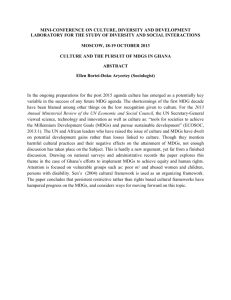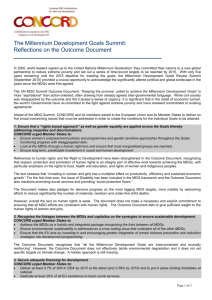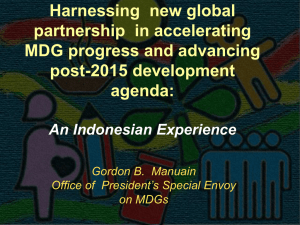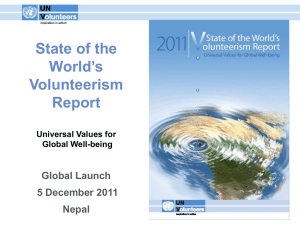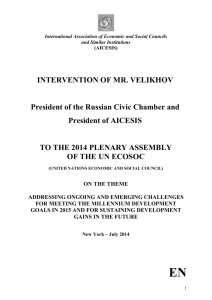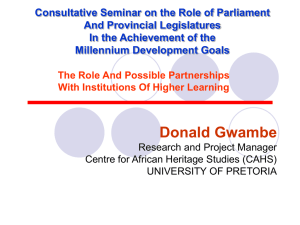Women`s Global Network for Reproductive Rights - UN-NGLS
advertisement
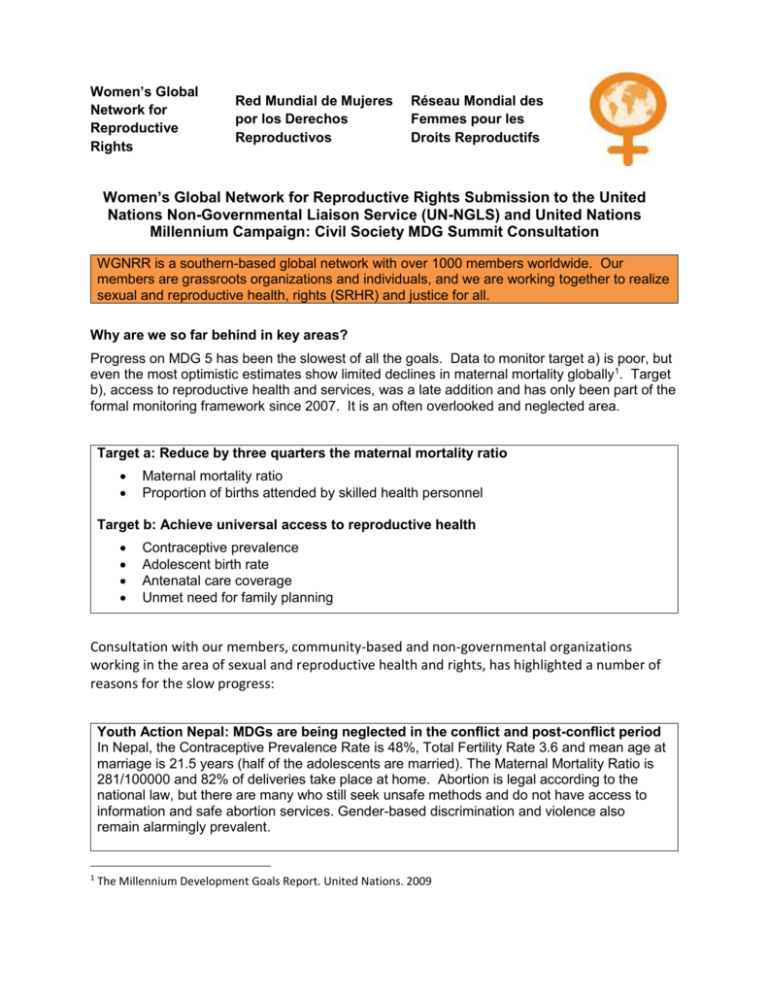
Women’s Global Network for Reproductive Rights Red Mundial de Mujeres por los Derechos Reproductivos Réseau Mondial des Femmes pour les Droits Reproductifs Women’s Global Network for Reproductive Rights Submission to the United Nations Non-Governmental Liaison Service (UN-NGLS) and United Nations Millennium Campaign: Civil Society MDG Summit Consultation WGNRR is a southern-based global network with over 1000 members worldwide. Our members are grassroots organizations and individuals, and we are working together to realize sexual and reproductive health, rights (SRHR) and justice for all. Why are we so far behind in key areas? Progress on MDG 5 has been the slowest of all the goals. Data to monitor target a) is poor, but even the most optimistic estimates show limited declines in maternal mortality globally1. Target b), access to reproductive health and services, was a late addition and has only been part of the formal monitoring framework since 2007. It is an often overlooked and neglected area. Target a: Reduce by three quarters the maternal mortality ratio Maternal mortality ratio Proportion of births attended by skilled health personnel Target b: Achieve universal access to reproductive health Contraceptive prevalence Adolescent birth rate Antenatal care coverage Unmet need for family planning Consultation with our members, community-based and non-governmental organizations working in the area of sexual and reproductive health and rights, has highlighted a number of reasons for the slow progress: Youth Action Nepal: MDGs are being neglected in the conflict and post-conflict period In Nepal, the Contraceptive Prevalence Rate is 48%, Total Fertility Rate 3.6 and mean age at marriage is 21.5 years (half of the adolescents are married). The Maternal Mortality Ratio is 281/100000 and 82% of deliveries take place at home. Abortion is legal according to the national law, but there are many who still seek unsafe methods and do not have access to information and safe abortion services. Gender-based discrimination and violence also remain alarmingly prevalent. 1 The Millennium Development Goals Report. United Nations. 2009 The Government has implemented some MDG-related initiatives, while NGOs and other organization are also greatly involved in efforts. Some donors and International NGOs are also providing funds. However, there is lack of partnership and clear coordination among state mechanism and other partners. Responsible ministry and government line agencies are also not sincere about reaching the MDGs and are neglecting the commitments made. Insufficient investment is being made in providing sexual and reproductive information and services, particularly for young people. Youth Dignity International, Nigeria: Poor governance and corruption are hindering progress towards the MDGs The maternal mortality rate in Nigeria is very high due to a lack of appropriate health facilities and services for pregnant women. It is said that large funds are budgeted for health, but in reality it is never spent in this way. Corruption and lack of financial transparency has been a major obstacle in achieving the MDGs in Nigeria. Movimiento Manuela Ramos, Peru: Safe abortion is critical to MDG 5 and improving maternal health Access to safe abortion continues to be a serious problem for Peruvian women. Women seek abortions as part of their basic right to health and wellbeing. However, religious and legislative restrictions mean that abortion is commonly practiced under unsafe conditions and is a major contributor to high incidences of maternal death, particularly in the case of poor and impoverished women. Despite the government’s commitments to the MDGs universal access to reproductive health is far from being a reality. Reproductive health is intrinsically linked to underlying issues of rights and justice. These are complex concepts, without clear ‘sectoral ownership’. They are determined by social dynamics and power relations and are broader than health. Sustained progress relies on tackling these. Lack of sufficient attention and political will. The low value and status given to women means issues relating to them are neglected by decision makers creating a vicious cycle of inequity. This links directly to MDG 3 and the promotion of gender equality and empowerment of women. Poor governance. Funds committed to health and in particular SRHR often do not make it to the people on the ground but are lost through corruption and poor management. Sensitive issues. Politicians prefer to avoid the sensitive issues related to maternal and sexual and reproductive health. They are uncomfortable talking about sex and unwilling to oppose powerful anti-choice groups. Despite the fact that up 13% of maternal deaths worldwide are the result of unsafe abortion2 in many countries abortion is illegal and or heavily stigmatized and opposed by religious groups. In some contexts this also applies to contraceptives. Disease orientation. Health investment tends to be disease-oriented with lower priority on broader health and wellbeing including reproductive rights. 2 Abortion Worldwide: A decade of uneven progress. Guttmacher Institute, 2009 Flawed development assistance. Funds shifted to HIV/AIDs, lack of integration with RSHR. Donors demand impact over short-time periods. Weak enforcement mechanisms. The Millennium Declaration is a consensus document, and signatories are bound only by their own moral obligation. However, the MDGs link directly to Human Rights which are strong internationally binding legal obligations, and the right to the enjoyment of the highest attainable standard of health first enshrined in the Universal Declaration of Human Rights as long ago as 1948. More needs to be done to draw synergies between the MDGs and human rights and strengthen enforcement mechanisms. Proposals to accelerate progress There are only five years remaining for the MDGs and ICPD Programme of Action Goals to be reached. If the next five years are to see any progress, it is imperative to heed the lessons from the past ten years. Consultation with our members highlights some key principles for accelerating progress: Nepal, Youth Action Nepal To accelerate progress towards the MDGs in Nepal, the following actions are urgently needed: Increase government and civil society partnerships Government officials and ministries must follow through on commitments made in different forums Resources and opportunities need to be channeled to the community level. Increase peoples’ participation in the MDG process. Nigeria, Youth Dignity International United Nations and international donors need to ensure that governments are held accountable for commitments to women’s health. They need to support local actors to take on this role. Capacity building and necessary facilities are needed in order to tackle the problem of maternal mortality in Nigeria. Increase consultation and participation of the people and communities that the MDGs are meant to be about: The MDGs are about improving the lives of people living in poverty. It is without question that the people who are living on the margins of society must be meaningfully included in the development and implementation of policies and programmes. States need to assume responsibility for carrying out the related commitments before sustained changes are possible. Strengthened partnerships between civil society and government are badly needed. Support civil society to hold Governments’ accountable for the MDGs: Improved monitoring and accountability mechanisms are needed at all levels so that governments are held accountable for their commitments and will not shy away from so-called ‘sensitive’ issues. National progress reports towards the implementation of MDG 5b need to go beyond national aggregate statistics, to include analyses about different realities depending on geographic, socio-economic and demographic factors. Monitoring mechanisms also need to incorporate meaningful civil society participation, with particular attention to populations from systematically marginalised backgrounds, including young people. Generate political will and financial investment for Governments to meet their commitments to the MDGs and in particular MDG 5b. Governments with support from development partners, must: -Reform laws relating to reproductive and sexual health rights. All laws that contradict or undermine the fulfilment of MDG 5b and the ICPD PoA must be amended and in particular those that criminalise abortion and outlaw expression of sexual identity and preference. -Ensure access to a full range of contraceptive information and services. These methods must be voluntary, non-coercive, and gender-sensitive and provided on a nonjudgemental, non-discriminatory basis (including condoms, oral contraceptive pills and intra-uterine devices). - Ensure access to safe, legal abortion information services. These services should include a wide range of methods (surgical and medical), appropriate to the gestational age and livelihood realities. These information and services should: a) receive sustained and adequate public investment and support, and b) be publicly accessible and available nationwide to rural and urban communities, including marginalised populations. -Develop comprehensive education in school curricula about SRHR. Practical implementation of school lessons should be gender-sensitive, empowering, and nondiscriminatory. All of the MDGs rely on progress in MDG5b . Universal access to reproductive health is closely linked to gender equality (MDG 3), child health (MDG 4), HIV and other infectious diseases (MDG 6) and fundamentally to poverty and hunger. If we are to achieve the commitments made in the MDGs, the world must take women’s reproductive health seriously. Focusing on reproductive health and rights will require sustained political and financial commitment and a focus on the community level and engaging and listening to the people the MDGs were designed to help.
